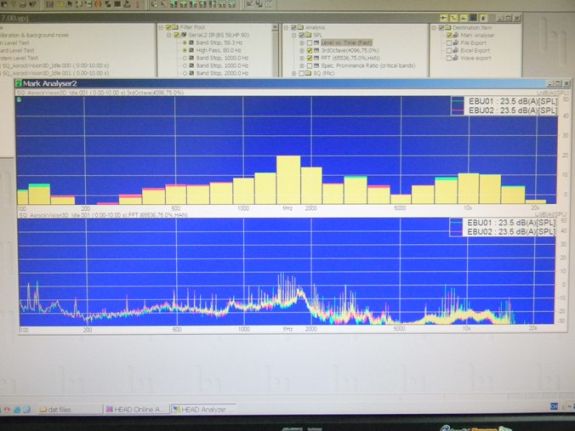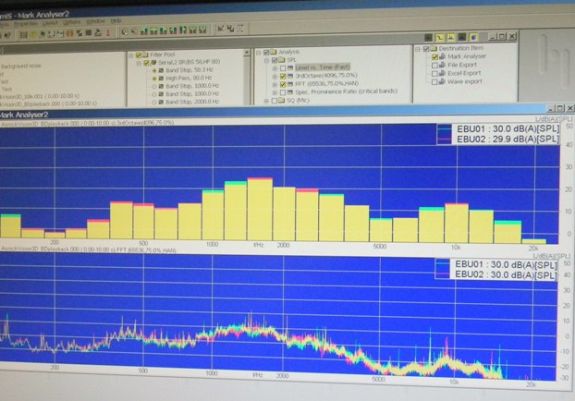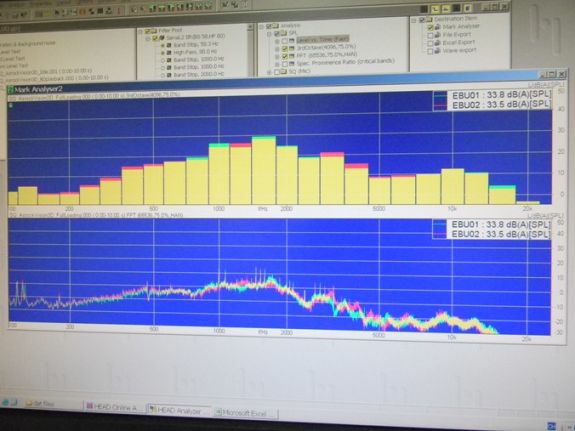ASRock's High-End Vision 3D HTPC Reviewed
by Ganesh T S on October 3, 2010 10:20 AM EST
HTPC enthusiasts are rightly concerned about the noise factor, heat and power consumption, ease of usage and many other criteria. We will tackle each of these concerns one by one in this section.
Noise
ASRock doesn't make any claims about the quietness of the system in their marketing material. We were pleasantly surprised upon looking at the noise reports. In the set of pictures below, a professional sound level detector was placed 2 ft away from the Vision 3D, and the sound level measurements were taken in various HTPC scenarios. The unit has a noise level of less than 35 dB at full load (for both CPU and GPU). In this respect, it is actually similar in performance to the Core 100. In fact, it is slightly better because of the elimination of one of the fans.
23.6 dB at Multimedia File Playback
33.8 dB at Full Load (Prime95 + Furmark)
Power Consumption
In order to get an idea of the power consumption numbers, the Prime95 and Furmark benchmarks were let run overnight to keep both the CPU and GPU completely loaded for an extended duration. Under these extreme conditions, we found the average power consumption to be around 82 W. At idle, the average power consumption was around 20 W.
These type of power consumption numbers have been enabled by ASRock's choice of going in for an Arrandale instead of a Clarkdale platform. This has resulted in a smaller form factor case design for the mini-ITX motherboard. Since there is not much heat to be dissipated, the cooling system is also appropriately small and silent.
Ease of Use
HTPC enthusiasts are concerned about how easy it is for their system to come out of standby. Existence of HDMI handshake issues upon return from standby is also a deal breaker for many. Fortunately, the Vision 3D has no issues in these two aspects. As long as the AC power adapter is connected to the system, the bundled MCE remote can be used to boot the system (even if the PC had been shut down previously). In order to shorten the boot times, ASRock supplies an Instant Boot utility. Using this, whenver the Vision 3D is shut down, it boots up once again and shuts down before the power can be safely removed. Upon power up, the boot up is instantaneous. If the user wants to put the PC in sleep mode, ASRock also supplies a Goodnight LED feature in the BIOS, which turns off the bright blue blinking LED in front. The MCE remote can also be used to bring the PC out of sleep mode.
Within Windows, the MCE remote can be made to work with a variety of applications such as XBMC, MediaPortal, MPC-HC and of course, Windows 7 Media Center. Blu Ray players such as PowerDVD and ArcSoft TMT can also be controlled with the help of the MCE remote. For the ideal I/O scenario, one probably needs to purchase a wireless keyboard / mouse combo.
It was seen in an earlier section that the Vision 3D happened to get a perfect score in the Anandtech Media Streamer Test Suite. The unit could playback all files using one program or the other, and people expect nothing else from a HTPC. Unfortunately, there is no single unified interface (from XBMC or MediaPortal or any other similar program) which could successfully play back all the files from within. There is definitely an ease of use issue existing here. However, this is not ASRock's fault, and will probably continue to exist on all HTPC platforms. Hopefully, projects such as XBMC's DSPlayer mature rapidly to alleviate this problem.














51 Comments
View All Comments
ganeshts - Sunday, October 3, 2010 - link
Thanks, fixed :)nitrousoxide - Sunday, October 3, 2010 - link
A Seagate Barracuda Momentus XT 500GB would do much better job than WD Scorpio Black.LtGoonRush - Sunday, October 3, 2010 - link
A Seagate Momentus XT 500GB would cost nearly twice as much as the WD Scorpio Black 500GB ($130 vs $75 at retail), and the performance difference is rather unimpressive. In the tests where the Seagate can make use of its SLC cache it can take the lead, but in most tests the Scorpio Black is faster, especially when seek times or write performance come into play, since those are Seagate's major weaknesses.BansheeX - Sunday, October 3, 2010 - link
Cool box but LOL at the THX logo being slapped on it. They used to put that on heavily compressed DVD mixes, not all of them good either. Consumers don't care anymore.ganeshts - Sunday, October 3, 2010 - link
Personally, I don't care too much about the THX either :) If you are using HDMI for audio, it doesn't even appear in the picture.The internal audio codec is advertised with THX, so the HTPC using it gets the additional marketing point too :)
tobrien - Sunday, October 3, 2010 - link
you guys did such an excellent job with this review! thanks for all the hard work and effort you guys put in!Shiitaki - Sunday, October 3, 2010 - link
I'm not seeing the value here. A thousand dollars to stream content, and play blurays? One of the previous replies you stated that there was no native bluray support for the mac mini, true. And there is for a machine running windows? Tacking on Cyberlink is not native support.That is way too much hardware for what it does, which illustrates how badly Windows is for a platform. You could do much better with less hardware. Which is the real problem with a htpc, the software, the operating system, and various codecs, and getting it to all work together. Too much complexity. Most of the processor is wasted on layers of software instead of doing actual work. Most of the effort is expended to compensate for lazy and inadequate programming, as well as DRM.
I understand the concept, I had a htpc for a couple of years, but after the frustration of trying to get surround sound to work in Cyberlink for Blurays, and the tech support to keep Windows working, I gave up. In fact it was specifically windows deciding to rebuild my music library from scratch every time I opened media center to play music. I want an appliance on the other end of the remote, having to search forums and break out a mouse and keyboard to trouble shoot something that worked the day before just fine should not be step two after pressing the power button.
In the the article, there is no details as to how much or little work it took to make the software environment to work. Did settings hold, did you have to do reconfigurations, update drivers, load codecs? I seriously doubt it worked out of the box. Working out of the box is the great failure of the pc industry. On the video quality you are hedging, saying that video quality will get better with driver updates? So it's not finished eh? That's the sad reality with the computer industry in general, nothing ships as a finished product.
The only thing this device seems to offer are endless possibilities to reward owners with a sense of accomplishment having solved issues preventing operations promised by the vendor. You can buy a nice bluray player, wd live, and still have 700 dollars for something else.
The real news is if you took it out of the box, plugged everything in, did a setup once, and spent the rest of the time using it. No drivers, patches, settings that reset themselves, or promises of a future update for something to work So what did it take to make it work like it's supposed to, what issues does it have? Did you listen to two channel, or full surround? How many error messages did you have to deal with?
ganeshts - Monday, October 4, 2010 - link
What you are looking for is a player like the upcoming Netgear NTV550. That would put it in the media streamer section. That would be like $700 cheaper than the Vision 3D, but, with the NTV choice, you are at the mercy of Netgear for firmware updates in case something you want doesn't work, and it also doesn't support 3D -- which is what this product is targeted towards.. For the Vision 3D running Windows, you have a number of open source developers who can enable core features like HD audio bitstreaming etc. -- Try getting open source devs to get those sort of features working on a SoC based device.The fact with the HTPC scene is that you do have to do some setup of sorts and deal with error messages and what no. However, sometimes, slapping on the latest XBMC build solves most problems. Our test suite is designed to give problems to various softwares, so deriding drivers / softwares on the basis of the difficulty in getting it to work is not the purpose of the review.
ggathagan - Monday, October 4, 2010 - link
Everything you state is true but, unfortunately, that can be said of computers in general. It's not limited to HTPC.You're also missing one of the major points of the HTPC: Its ability as a computer.
You don't get that from a standalone device.
You don't specify what version of MCE you were using, but if you weren't using the Windows 7 version it's not really a valid arguement.
I never tried the Vista version, but the Win 7 version has certainly come a looong way from the XP version.
And if you happen to be someone on a budget that wants to do it all with a single device, the price of the ASRock system is pretty attractive, even after adding the cost of the OS, monitor and BD software.
Hrel - Monday, October 4, 2010 - link
Pretty sure the hybrid Seagate Momentus XT is the fastest 2.5" drive they could have chosen. To all the other people talking about this egregious error, WD and Seagate are the only mechanical disk hard drive manufacturer's even worth looking at.